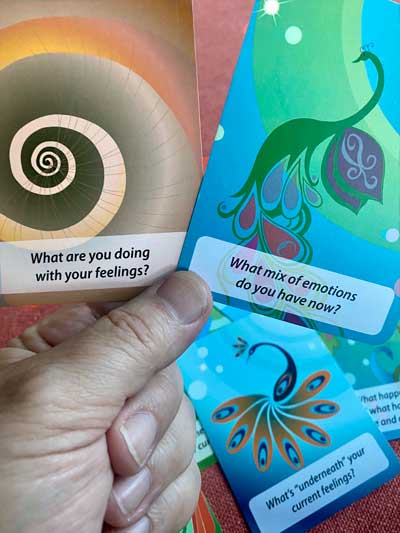EQ Coaches value all emotions as resources that provide insight and energy. But that doesn’t mean we “make” clients talk about feelings. In fact, often words get in the way of understanding emotions.
To become more effective with emotions as a coach (or someone using coaching), we can reframe our feelings about feelings – with a metaphor, EQ Coach Cards, and the Six Seconds Model.
Worried About Feelings
Last month at our EQ Coach Certification Foundations course in China, two of the participants were worried. I’d just finished a demo coaching session that included me and my client crying together. One asked, “But what if a client is uncomfortable talking about feelings, how can we do this?” And another, “In China, it’s not common to talk so openly about emotions.”
I laughed because almost ALL of my clients are also uncomfortable talking about feelings, at least at first. I explained: As an EQ Coach, I use feelings all the time. I tune into my own and my clients’ emotions – whether or not we talk about them. I let the client lead: I ask about feelings, and sometimes they share and sometimes they don’t – but in either case, the feelings are present, and I can use that data.
That said: I find most of my clients end up feeling (somewhat) comfortable talking about feelings, even if that’s not how they start. Why is that?
I suspect a big part is the work I’ve done to become more comfortable with emotions myself. Where I used to shy away, now I (usually) welcome feelings. When we are co-creating relationship, we provide one another subtle signals; for example, someone shares a bit of something difficult – and they notice how you react. If you become uncomfortable, most people back off, and the conversation stays on the surface.
This article is from the 🌱 EQ Coach Newsletter
Click here & choose the newsletters that will help you practice and grow emotional intelligence
The Middle Zone of Emotions: A Metaphor for Coaches
At the other extreme, I’ve shared before about pushing too hard. Remember the power of ‘lazy coaching’? As you know from the 3-D Contracting Process: When people feel pushed, they resist.
So the space for emotional honesty is somewhere in the middle: Neither uncomfortable avoiding, nor pushing. To find that space, I’d like to share a metaphor about what we can see in the middle spaces.
Usually when I walk on the beach, I look for sea glass.
Here’s some I collected today.

Most weeks, I head to Seacliff State Park a couple of times; there are often sections of the beach where rocks seem to gather.
I’m sure there’s glass in those rock piles… but it’s buried in complexity.

Instead, I look at the edges. I walk at the margins between rock, sand, and water. At these margins, I can see the sea glass shining.
Perhaps that’s also true of emotions and coaching? The deep piles of rock are a place for therapy. Frolicking in the waves is a place for friendly conversation. The margins are a place for coaching. In these margins, I can see emotions shining.

Maintaining a Coaching Mindset: Feelings About Feelings
The International Coaching Federation defines this competency in terms of our clients: “Develops and maintains a mindset that is open, curious, flexible and client-centered” – but as EQ Coaches, we know that we also need to coach ourselves.
So how do we shift to that open, curious, flexible stance with regard to our own emotions? In next week’s Coaching Connections webinar, we’ll explore this topic further.
Are you familiar with the EQ Coach Cards? They offer questions for each of the competencies in the Six Seconds Model of Emotional Intelligence. In the Know Yourself pursuit, we have two competencies to apply to this question of our feelings about feelings.
The first is to Enhance Emotional Literacy. In this context, we can invite ourselves to notice our feelings, and our feelings about those feelings. Imagine a client is feeling a big, challenging feeling.
1
Explore this card that says: What mix of emotions comes up for you?
On the back, one of the followup questions: What feelings are hiding behind other feelings?
2
Then, let’s consider the competency of Recognize Patterns and the card: What are you doing with your feelings?
On the back: Are you judging your feelings? Hiding them? Blasting them? Ignoring them?

Reframing Feelings with Compassionate Wisdom
Once you have done the Know Yourself work to get the data, you can move onto the next steps in the emotional intelligence process: Choose Yourself and Give Yourself.
Choosing is about shifting from reaction to response. One of the tools is to Navigate Emotions: In last month’s Connect & Learn, we touched on the work of becoming more comfy with uncomfy feelings. Mariaelena Welch, who leads the EQ Coach Certification in North America, talked about the power of validation (here’s a lovely eLearning course about validating emotions). Not fighting, not changing: Simply acknowledging… and then, knowing all feelings have value, asking: What’s the message of this feeling?
Giving: One of the competencies in this part of the model is to Increase Empathy. Empathy is not just for others, it’s mutual. I suspect that self-empathy is actually the starting point for all empathy. So let’s apply it here: You’ve identified your feelings and reactions about uncomfortable feelings. You’ve validated the feeling and started to explore it.
Now, step into compassion: What is your own compassionate wisdom for yourself?
Please give yourself time and space for this process. It’s not easy to step out of the cultural norms of judging some feelings as negative, and suppressing, hiding, shifting, or transferring those uncomfortable feelings. The good news: I’ve seen hundreds of coaches (including myself) get comfy with uncomfy feelings… and then our clients do too.
Whether you’re a professional coach, or contemplating earning certification as a professional emotional intelligence coach*, or you’re someone who uses coaching techniques to support others: Six Seconds’ approach starts on the inside.
* Did you know? In addition to top-level accreditation from the International Coaching Federation, the EQ Coach Certification is one of a handful of coaching certifications in North America that also provides master’s level credit? You’ll earn almost ⅓ of your MBA or MA in this program.
… and don’t forget to Click here to subscribe to the EQ Coach Newsletter.
For more on EQ and Coaching 🌱, I recommend:
- How Emotional Intelligence Coaches Use Emotions in Goal Setting - October 2, 2024
- 3 Winning Strategies for Successful Change Leadership: Coaching with Emotional Intelligence - September 4, 2024
- 3 Emotional Intelligence Tips for the Essence of Coaching - July 31, 2024

Thanks Josh. You hit a nerve. I talk about Empathy and practice giving others empathy – being more accepting, curious and less judgemental but do not give myself self empathy. ” I suspect that self-empathy is actually the starting point for all empathy.” WOW. So now I will give myself some advice as if I was giving it to a friend. You did the best you could with the skills you had at the time. Now I know so much more about EQ, I give myself a hard time but…. I did the best I could with the skills I had at the time and now I am a better role model.